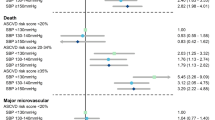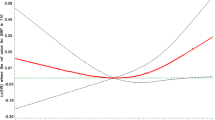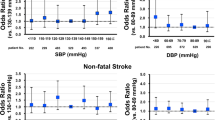Abstract
There is still debate on whether the relationship between blood pressure (BP) and risk of cardiovascular diseases (CVD) in patients with type 2 diabetes (T2D) is linear or not. Since these cardio-metabolic disturbances share interrelated complex pathogenic mechanisms, we aimed to assess the relationship of baseline systolic (SBP)/diastolic pressures with CVD and coronary heart disease (CHD) events in a cohort of Iranians with T2D during a median follow-up of 8.8 years. Of all 1009 eligible participants with T2D with a mean (s.d.) age of 54.4 (11.6) years and free of CVD at baseline, we primarily focused on 260 participants undergoing anti-hypertensive treatment. Multivariate Cox proportional hazard models were used to evaluate hazard ratios (HR) of BP categories for CVD and CHD events. Also, multivariable regression modelling was applied to obtain their risk curve. We detected a J-shaped phenomenon between the continuous baseline BP and risk of CVD events. Considering 130⩽SBP<140 mm Hg as reference, a SBP ⩾140 mm Hg was associated with increased CVD (HR [95% confidence interval (CI)]: 2.43 [1.23–4.82]) and CHD (HR [95% CI]: 2.05 [1.02–4.13]) risk. However, a SBP⩽120 mm Hg in those with drug-treated hypertension also showed higher risk for CVD (HR [95% CI]: 2.80 [1.24–6.34]) and CHD events (HR [95% CI]: 2.39 [1.03–5.57]). Our findings revealed that the risk for macrovascular morbidity events was inversely associated with BP reduction below the level of 120/80 mm Hg for those with diabetes. People with diabetes might benefit from a BP management to a moderate range of 120/80–140/90 mm Hg for CVD risk reduction.
This is a preview of subscription content, access via your institution
Access options
Subscribe to this journal
Receive 12 digital issues and online access to articles
$119.00 per year
only $9.92 per issue
Buy this article
- Purchase on Springer Link
- Instant access to full article PDF
Prices may be subject to local taxes which are calculated during checkout

Similar content being viewed by others
References
Williams B . Blood pressure and diabetes: a fatal attraction. Eur Heart J 2013; 34: 3395–3397.
Weidmann P, Boehlen L, De Courten M, Ferrari P . Antihypertensive therapy in diabetic patients. J Hum Hypertens 1992; 6: S23–S36.
Izzo R, de Simone G, Trimarco V, Gerdts E, Giudice R, Vaccaro O et al. Hypertensive target organ damage predicts incident diabetes mellitus. Eur Heart J 2013; 34: 3419–3426 eht281.
Williams B . Treating hypertension in patients with diabetes: when to start and how low to go? JAMA 2015; 313 (6): 573–574.
Wong ND . Epidemiological studies of CHD and the evolution of preventive cardiology. Nat Rev Cardiol 2014; 11 (5): 276–289.
Derakhshan A, Sardarinia M, Khalili D, Momenan AA, Azizi F, Hadaegh F . Sex specific incidence rates of type 2 diabetes and its risk factors over 9 years of follow-up: Tehran Lipid and Glucose Study. PLoS ONE 2014; 9 (7): e102563.
Bozorgmanesh M, Hadaegh F, Mohebi R, Ghanbarian A, Eskandari F, Azizi F . Diabetic population mortality and cardiovascular risk attributable to hypertension: a decade follow-up from the Tehran Lipid and Glucose Study. Blood Press 2013; 22 (5): 317–324.
Adler AI, Stratton IM, Neil HAW, Yudkin JS, Matthews DR, Cull CA et al. Association of systolic blood pressure with macrovascular and microvascular complications of type 2 diabetes (UKPDS 36): prospective observational study. BMJ 2000; 321 (7258): 412–419.
Chobanian AV, Bakris GL, Black HR, Cushman WC, Green LA, Izzo JL et al. Seventh report of the joint national committee on prevention, detection, evaluation, and treatment of high blood pressure. Hypertension 2003; 42 (6): 1206–1252.
James PA, Oparil S, Carter BL, Cushman WC, Dennison-Himmelfarb C, Handler J et al2014 Evidence-based guideline for the management of high blood pressure in adults: report from the panel members appointed to the Eighth Joint National Committee (JNC 8). JAMA 311 (5): 507–520.
Group AS. Effects of intensive blood-pressure control in type 2 diabetes mellitus. N Engl J Med 2010; 362 (17): 1575.
Arguedas JA, Leiva V, Wright JM . Blood pressure targets for hypertension in people with diabetes mellitus. Database Syst Rev 2013; (10): CD008277.
Bangalore S, Kumar S, Lobach I, Messerli FH . FH. blood pressure targets in subjects with type 2 diabetes mellitus/impaired fasting glucose observations from traditional and bayesian random-effects meta-analyses of randomized trials. Circulation 2011; 123 (24): 2799–2810.
Denardo SJ, Gong Y, Nichols WW, Messerli FH, Bavry AA, Cooper-DeHoff RM et al. Blood pressure and outcomes in very old hypertensive coronary artery disease patients: an INVEST substudy. Am J Med 2010; 123 (8): 719–726.
Fuchs F, Fuchs S . Blood pressure targets in the treatment of high blood pressure: a reappraisal of the J-shaped phenomenon. J Hum Hypertens 2014; 28 (2): 80–84.
Wright JT, Williamson JD, Whelton PK, Snyder JK, Sink KM, Rocco MV et al. A randomized trial of intensive versus standard blood-pressure control. N Engl J Med 2015; 373 (22): 2103–2116.
Emdin CA, Rahimi K, Neal B, Callender T, Perkovic V, Patel A . Blood pressure lowering in type 2 diabetes: a systematic review and meta-analysis. JAMA 2015; 313 (6): 603–615.
Azizi F, Rahmani M, Emami H, Mirmiran P, Hajipour R, Madjid M et al. Cardiovascular risk factors in an Iranian urban population: Tehran lipid and glucose study (phase 1). Soz Praventivmed 2002; 47 (6): 408–426.
Azizi F, Ghanbarian A, Momenan AA, Hadaegh F, Mirmiran P, Hedayati M et al. Prevention of non-communicable disease in a population in nutrition transition: Tehran Lipid and Glucose Study Phase II. Trials 2009; 10 (1): 5.
Mohebi R, Mohebi A, Ghanbarian A, Momenan A, Azizi F, Hadaegh F . Is systolic blood pressure below 150 mm Hg an appropriate goal for primary prevention of cardiovascular events among elderly population? J Am Soc Hypertens 2014; 8 (7): 491–497.
Levey AS, Stevens LA, Schmid CH, Zhang YL, Castro AF, Feldman HI et al. A new equation to estimate glomerular filtration rate. Ann Intern Med 2009; 150 (9): 604–612.
Hadaegh F, Harati H, Ghanbarian A, Azizi F . Association of total cholesterol versus other serum lipid parameters with the short-term prediction of cardiovascular outcomes: Tehran Lipid and Glucose Study. Eur J Cardiovasc Prev Rehabil 2006; 13 (4): 571–577.
Afsharian S, Akbarpour S, Abdi H, Sheikholeslami F, Moeini AS, Khalili D et al. Risk factors for cardiovascular disease and mortality events in adults with type 2 diabetes: a 10 year follow‐up: Tehran lipid and glucose study. Diabetes Metab Res Rev 2016; 32: 596–606.
Chalise P, Chicken E, Mcgee D . Time Scales in Epidemiological Analysis: An Empirical Comparison. International Journal of Statistics and Probability 2016; 5: 91.
Royston P, Sauerbrei W . Multivariable model-building: a pragmatic approach to regression anaylsis based on fractional polynomials for modelling continuous variables, vol. 777. John Wiley & Sons: Oxford, UK, 2008.
Sauerbrei W, Royston P, Binder H . Selection of important variables and determination of functional form for continuous predictors in multivariable model building. Stat Med 2007; 26 (30): 5512–5528.
Hellstrom H . The altered homeostatic theory: a hypothesis proposed to be useful in understanding and preventing ischemic heart disease, hypertension, and diabetes—including reducing the risk of age and atherosclerosis. Med Hypotheses 2007; 68 (2): 415–433.
Messerli FH, Mancia G, Conti CR, Hewkin AC, Kupfer S, Champion A et al. Dogma disputed: can aggressively lowering blood pressure in hypertensive patients with coronary artery disease be dangerous? Ann Intern Med 2006; 144 (12): 884–893.
Sleight P, Redon J, Verdecchia P, Mancia G, Gao P, Fagard R et al. Prognostic value of blood pressure in patients with high vascular risk in the ongoing Telmisartan alone and in combination with Ramipril Global Endpoint Trial study. J Hypertens 2009; 27 (7): 1360–1369.
Bangalore S, Qin J, Sloan S, Murphy SA, Cannon CP and Investigators PI-TT. What is the optimal blood pressure in patients after acute coronary syndromes? Relationship of blood pressure and cardiovascular events in the pravastatin or atorvastatin evaluation and infection therapy–thrombolysis in myocardial infarction (PROVE IT-TIMI) 22 trial. Circulation 2010; 122 (21): 2142–2151.
Cederholm J, Gudbjörnsdottir S, Eliasson B, Zethelius B, Eeg-Olofsson K, Nilsson PM . Blood pressure and risk of cardiovascular diseases in type 2 diabetes: further findings from the Swedish National Diabetes Register (NDR-BP II). J Hypertens 2012; 30 (10): 2020–2030.
Bangalore S, Messerli FH, Wun C-C, Zuckerman AL, DeMicco D, Kostis JB et al. J-curve revisited: an analysis of blood pressure and cardiovascular events in the treating to new targets (TNT) trial. Eur Heart J 2010; 31: 2897–2908.
Bangalore S, Kumar S, Volodarskiy A, Messerli FH . Blood pressure targets in patients with coronary artery disease: observations from traditional and Bayesian random effects meta-analysis of randomised trials. Heart 2013; 99 (9): 601–613.
Li W, Katzmarzyk PT, Horswell R, Wang Y, Johnson J, Hu G . Blood pressure and all-cause mortality among patients with type 2 diabetes. Int J Cardiol 2016; 206: 116–121.
Kovesdy CP, Bleyer AJ, Molnar MZ, Ma JZ, Sim JJ, Cushman WC et al. Blood pressure and mortality in US veterans with chronic kidney disease: a cohort study. Ann Intern Med 2013; 159 (4): 233–242.
Torre J, Bloomgarden Z, Dickey R, Hogan M, Janick J, Jyothinagaram S et al. American Association of Clinical Endocrinologists Medical Guidelines for Clinical Practice for the diagnosis and treatment of hypertension. Endocr Pract 2006; 12 (2): 193–222.
American Diabetes Association. Glycemic targets. Diabetes Care 2015; 38 (Supplement 1): S33–S40.
Acknowledgements
We express our appreciation to the participants of district 13, Tehran, for their enthusiastic support in this study. This study was supported by Grant No. 121 from the National Research Council of the Islamic Republic of Iran. The funders had no role in study design, data collection and analysis, decision to publish, or preparation of the manuscript.
Author information
Authors and Affiliations
Corresponding author
Ethics declarations
Competing interests
The authors declare no conflict of interest.
Additional information
Supplementary Information accompanies this paper on the Journal of Human Hypertension website
Supplementary information
Rights and permissions
About this article
Cite this article
Riyahi-Alam, S., Derakhshan, A., Mansournia, M. et al. Blood pressure and cardiovascular morbidity risk in type 2 diabetes with hypertension over a decade of follow-up: evidence for J-shaped phenomenon. J Hum Hypertens 31, 415–421 (2017). https://doi.org/10.1038/jhh.2016.94
Received:
Revised:
Accepted:
Published:
Issue Date:
DOI: https://doi.org/10.1038/jhh.2016.94



